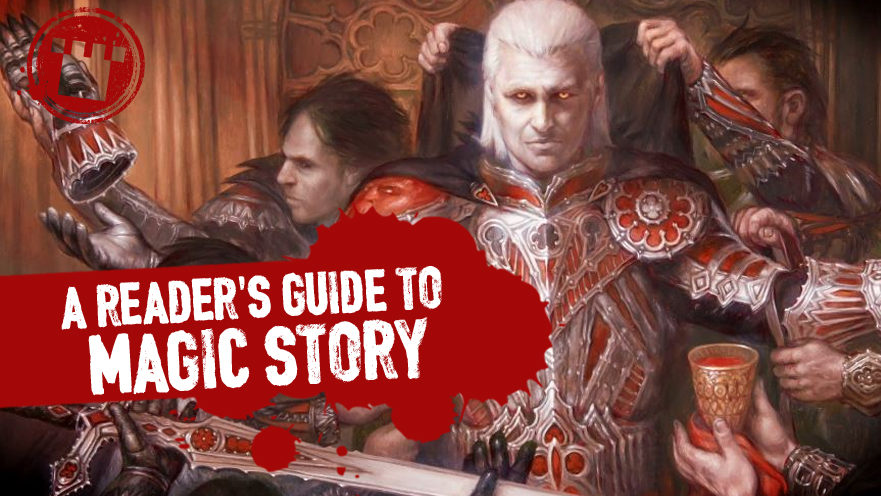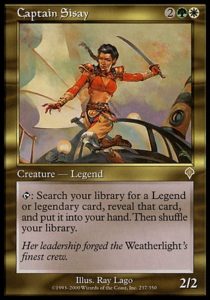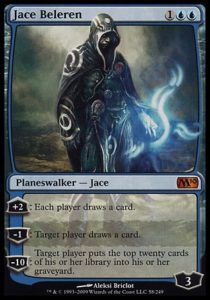The release of Commander 2017 is nearly here, and with these four decks will come a whole slew of new legendary creature cards. While many will rejoice over the new mechanics and color combinations, those of us who have followed the Magic storyline for years will be overjoyed to finally see certain characters on a card for the first time. I cannot tell you how thrilled I was to see an upcoming O-Kagachi card, or to hear that we’d finally get to meet Edgar Markov. These characters have cast long shadows across Magic‘s lore for years, and it’s great to finally have faces and colors to go with the ones in our imagination.
The release of these cards highlights just how deep and rich Magic‘s story has been over the years. However, just as learning twenty-five years of keywords and cards can be daunting for a new player, absorbing an equal amount of lore and storyline can seem like an impossible task for someone just now dipping their storytelling toes into the MTG waters. Where does one begin? Do you need to start at the beginning, or can you skip to the middle and fill in the rest with summaries? To help you tackle these questions, allow me to share my quick Reader’s Guide to MTG Story, which breaks up a quarter-century of lore into five clearly defined chunks.
First Era: The Dark Ages – Alpha (1993) through Visions (1997)
Told Through: books, comics, flavor text
Magic‘s earliest days had little story beyond standard fantasy tropes – wizards, lightning bolts, powerful beasts, etc. However, even Alpha contained references to two characters who would go on to define much of the next decade of lore – Urza and Mishra. The backstory behind these two mysterious names would be explored in the Antiquities expansion, which delved into the past of these two brothers, who waged a great war against each other on the plane of Dominaria. Other early expansions, such as Legends and Fallen Empires, had their stories told through the ARMADA comic books series, before Wizards of the Coast started publishing full novels in the late 1990s, which retold and retconned the Brothers’ War and other early stories.
I have dubbed this era The Dark Ages due to the lack of story continuity (as well as the fact that it includes an expansion named The Dark). This was an era of transition, as WotC switched from the early Harper Prism novels (which exist outside of established MTG canon) to comics, before finally settling on official novels. By the end of this era, though, a clear storyline was emerging, as the effects of the Brothers’ War brought about the Ice Age and the events of the early Mirage block. By the end of that block, we’d be introduced to Magic‘s first true set of consistent heroes.
Second Era: The Weatherlight Era – Weatherlight (1997) through Apocalypse (2001)
Told Through: books, flavor text, card art
For many of us who started playing right around the year 2000, Magic‘s story is synonymous with the adventures of the Weatherlight – a planeswalking airship with a motley crew of heroes, antiheroes, and oddballs. These included the swashbuckling Gerrard Capashen and the steadfast Captain Sisay, alongside Squee, Karn, and many other names familiar to even newer Magic players. Their adventures would take them to the dark world of Rath in the Tempest block and the bustling markets of Mercadia, before finally culminating in the all-out war on Dominaria of the Invasion block. Over the course of these stories, Gerrard would learn that he is the inheritor of something called the Legacy – a collection of artifacts and magic that the old Planeswalker Urza had assembled to defeat his archenemy – the Phyrexians and their overlord Yawgmoth. Urza, Gerrard, and the Legacy would ultimately defeat Yawgmoth during the Apocalypse storyline, albeit at great cost.
The Weatherlight Saga saw an unprecedented amount of the game’s story playing out on the cards themselves. Particularly in all three sets of the Tempest block, you can see pivotal moments playing out in the card art, or through the flavor text. This is also the era that I most often recommend as a starting point for MTG lore. The Rath and Storm anthology, edited by Peter Archer, is a fantastic read if you can find a copy, introducing you to characters that would define all of Magic‘s story moving forward.
Third Era: The Post-Weatherlight Era – Odyssey (2001) through Eventide (2008)
Told Through: books
Without getting into too many spoilers, the Weatherlight Saga ends with great finality. Magic would need a new set of characters to carry the torch forward. Rather than starting up another great arc, WotC would take a more modular approach for the next seven years, showcasing new planes and characters each year, often with little narrative connectivity between them. While the first three blocks of this era – Odyssey, Onslaught, and Mirrodin – share some strong through lines, the Kamigawa and Ravnica blocks are essentially standalone adventures. Kamigawa even takes place thousands of years in Magic‘s past! All these loose threads would end up tied together in the Time Spiral block, which saw the return of characters and locations from all throughout Magic‘s history. Evidently, millennia of magical wars and shenanigans had irrevocable damaged the fabric of existence, and the Time Spiral stories revolve around a cadre of planeswalkers shouldering the responsibility of mitigating and repairing that damage.
The biggest influence of this wide swath of Magic lore is the change in the nature of planeswalkers. While older characters like Urza, Karn, and Teferi were nearly god-like in their magical powers, the events of Time Spiral created the modern iteration of planeswalkers, who possess cool magical powers but are considerably more mortal and relatable. This era of storytelling can often feel the most intimidating to MTG lore newbies, with dozens of characters and details to track, along with constant fleeting references to the game’s past. Following the soft universal reboot of Time Spiral, we’d see one more standalone story, the Lorwyn/Shadowmoor cycle, which served as a sort of interlude to the rest of Magic‘s future.
Fourth Era: The Planeswalker Era – Shards of Alara (2008) through Dragons of Tarkir (2015)
Told Through: books, e-books, comics, online articles, flavor text
The major motivation for changing the powers of Planeswalkers was to once again center Magic‘s story around characters who could travel from world to world. This gave the storyline a cast of familiar faces that fans could root for – Jace, Chandra, Liliana, and so on. The first three blocks of this era also introduced (or reintroduced) the Big Three antagonistic forces of modern Magic: Nicol Bolas in the Alara block, the Eldrazi in Zendikar, and the reorganized Phyrexians in Scars of Mirrodin. These story threads would weave in and out of each consecutive block, as the central characters explored the multiverse alongside, or in conflict, with each other.
This era contains by far the highest diversity of story sources. While the stories of this era are more widely available than the old, long-out-of-print paperback novels, tracking each piece of the puzzle down and connecting them can be exhausting. However, I strongly believe that it’s worth it! While we have since moved on to a fifth era of MTG storytelling, the Planeswalker Era laid integral groundwork for all the storylines we see today. The growing roster of Planeswalkers introduced during these seven years helped usher in Magic‘s strongest era of character-driven narratives.
Fifth Era: The Gatewatch Era – Magic Origins (2015) – present
Told Through: online articles, card art, flavor text
We’ve finally reached the present days of Magic! With Magic Origins, WotC took their existing structure of Magic story one step forward and consolidated their narrative around a small handful of central, recurring characters. Drawing on comic book team-ups like the Avengers and the Justice League, the quintet of Planeswalkers that formed the initial Gatewatch firmly anchored the story on familiar faces. We would get to know these characters as rich, three-dimensional beings, with motivations and biases that would influence the story for years down the line. As the Gatewatch era has progressed, there’s been some fine-tuning of just how prevalent each character should be in the stories, but Magic‘s lore seems well-positioned for the future. In fact, in less than a year, we’ll be heading back to Dominaria itself, the plane where all this began, bringing Magic‘s vibrant storytelling in a full loop.
Do you have a specific part of the Magic story or lore you want to see discussed on the Card Kingdom blog? Let me know at @Simon_V_Irving on Twitter!

Simon is a Retail Sales Specialist at Mox Boarding House Seattle. He started playing Magic during Odyssey block, finding success on the Junior Super Series circuit and eventually playing at the 2004 US Nationals. After a multi-year break from the game, he was brought back with the reprinting of his favorite card, Lightning Bolt, in the 2010 Core Set. Simon is a loyal Red Deck Wins player and is always doing his best to win with Mountains in every Constructed format. He has a deep affection for the Magic storyline and will happily discuss the peculiarities of the Kamigawa block with you upon request.



